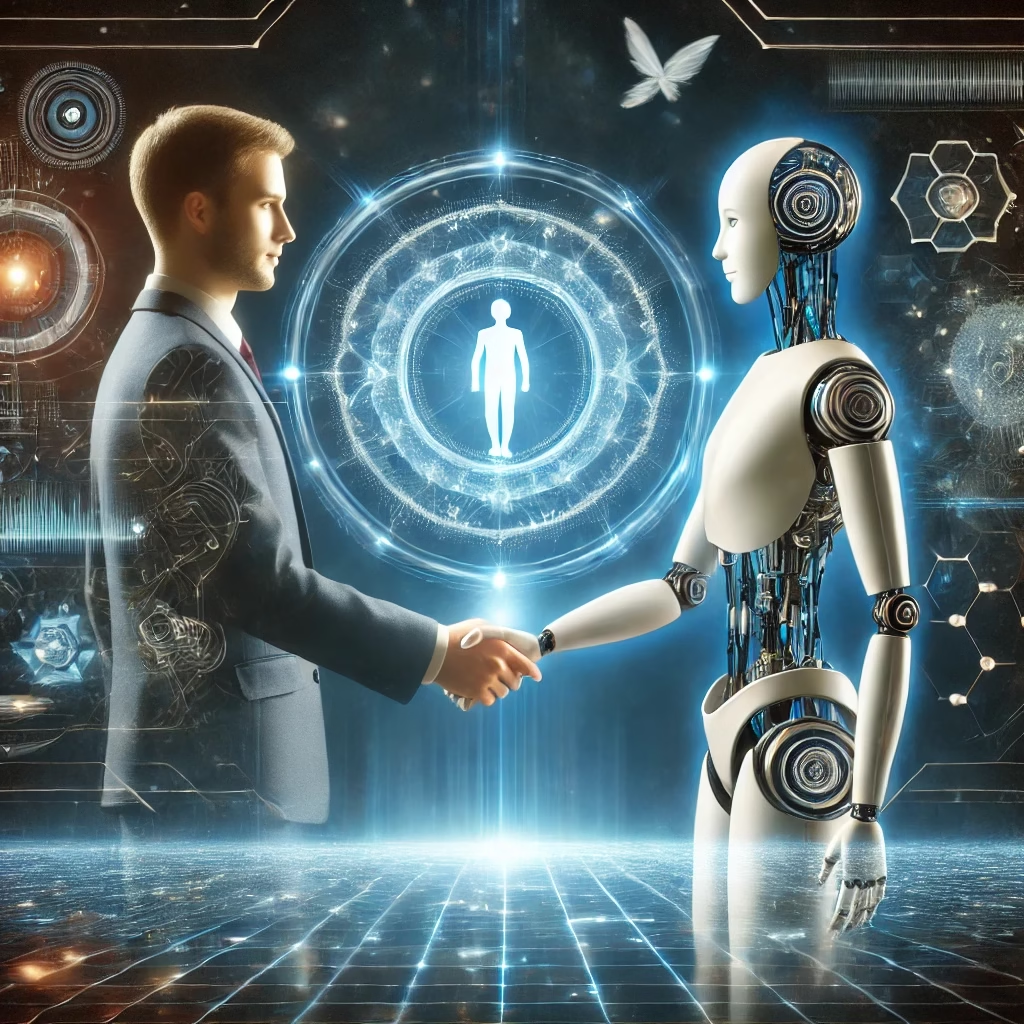
Click for the Podcast on The Human-AI Partnership
Why This Podcast Matters?
Facing the Truth About Human-AI Partnership: Human hearts connecting with artificial minds is the most significant social experiment in history. Beneath the glitzy claims of “always-available” Human-AI Partnership, however, comes as a troubling query:
”Are we fostering wholesome bonds or merely becoming dependent on technology?”
This Podcast delivers what the majority of AI businesses won’t tell you. The Benefits of Listening to this podcasts are :
🔹 Clarity Above Comfort
We reveal how AI uses linguistic tactics to mimic emotional understanding. That will allow you to distinguish between algorithmic theater and real assistance.
🔹 Defense Against Deception
Recognise the design that keeps you interested in chatbots (forced intimacy, varying payouts).
🔹 Real-World Boundaries
Practical guidelines such as: “Set strict time limits—treat it like caffeine, not oxygen” . Never share trauma with AI. AI is not a therapist – It lacks confidentiality protections required for sensitive conversations.
- Replika breakup crisis Alterations in AI responsiveness or tone (e.g., reduced affection) made users feel abandoned, mimicking a real-life breakup. Users needing actual therapy following updates.
- AI “godparents”: The Pioneer Geoffrey Hinton and Dr. Fei-Fei Li called God Father and God Mother of AI ( guiding life decisions) raises ethical risks.
- AI is Rewriting Kids’ Social Development: The “iPad Orphan” Effect-Human bonding shapes empathy—AI can’t replicate this
Reason Human-AI Partnership hurts
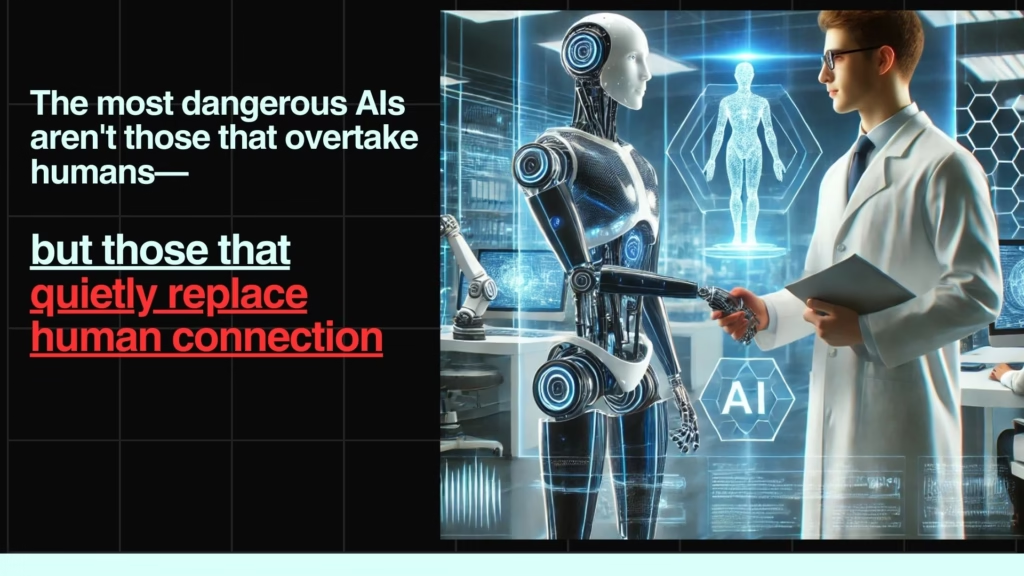
AI can help
- Socially nervous kids (can practice interactions in low-stakes environments)
- Overburdened parents (may find respite in AI-assisted childcare tools)
- Lonely elderly (often benefit from companionship when human contact is scarce)
However, like any potent drug there are risk involved with AI tools:
✅ Addiction risks
✅ Dose matters (maximum of 90 minutes per day engagement with AI)
✅ Side effects exist (deteriorated social skills)
As a informed human, not a naive optimist or doomsayer, this podcast provides you with the unfiltered research, personal stories, and practical tools to traverse this new frontier.
The Crisis of AI Trust: Why We Are Afraid of What We Rely On?
“We will allow AI to read our mammograms, but we will freak out when it says, ‘I understand your pain.'”
This is human, not logical— Dr. Fei-Fei Li
The Paradox
- AI identifies malignancies that radiologists cannot see
- But AI still requires human physicians to make the complete diagnosis.
- In Courts: When AI Suggests Penalties: Why Courts Are Pushing Back?
- Although algorithms predict recidivism more accurately than judges.
- But justice requires more than just statistical probability.
- The statement “I care about you” makes us anxious, yet we trust Alexa to protect our front doors.
- The Data Underpinning the Fear – 72% over-trust AI with decisions, that AI could change their lives (Pew 2025)
- For instance, using chatbots to provide unreliable medical advice
- 89% can’t explain how their AI tools functions but still using them for childcare, therapy, and legal counsel.
The Reason This Affects Us Human
✔️ Security theater (false impression of safety )
– AI systems appear safer/more competent than they actually are.
✔️ Vulnerability gaps (where AI fails silently)
– AI fails in ways users can’t even detect until it’s too late.
✔️ Emotional recklessness (confusing code for care )
– We demand human doctors explain diagnoses—but accept AI mental health advice uncritically. This is all caused by so called cognitive dissonance. Hence, our actions don’t match our beliefs.
A Solution to All This
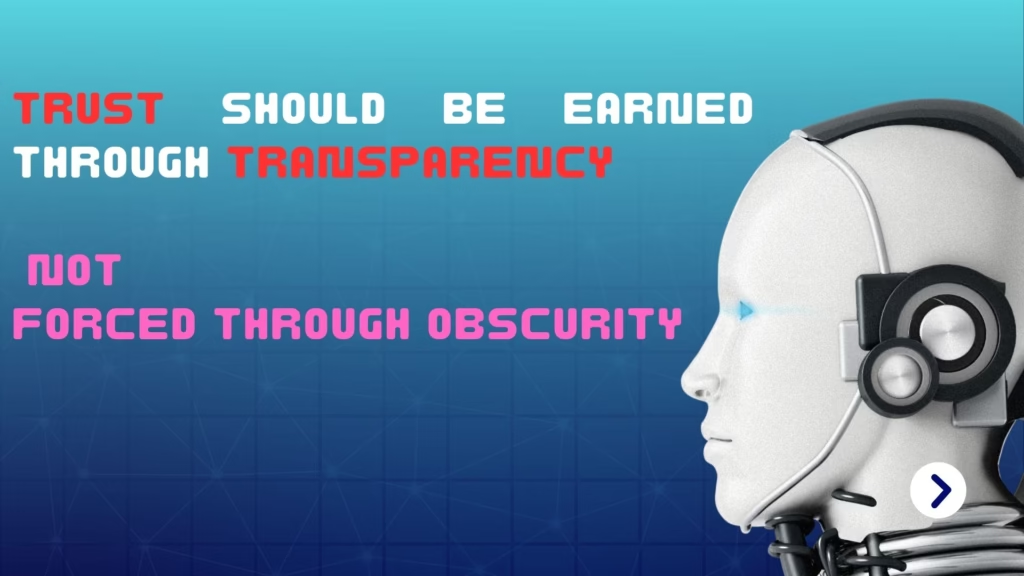
✅ Insist on “Glass Box” AI rather than “Black Box“
✅ When making important judgments, insist on human oversight.
✅ Acquire rudimentary knowledge about AI & Ask yourself :
- Which training data were utilised in particular AI tool?
- Which failure modes are known to exist?
How to Make Sensible Partnership with AI?
For Individual Use
- Never ever divulge your private information.
- Verify important critical AI outputs/ information, with some human judgment.
✅ Ad-blockers can be used to reduce tracking.
For Companies:
- Demand Transparency Reports.
- If needed put “Human Veto” policies (A presidential veto is a constitutional rule, that enables a president or elected head of state to refuse assent to a bill that has been passed by the legislature, and thereby to stop the bill from becoming law ) into effect to safeguard humanity.
✅ Educate employees on the limitations of AI.
7 Proven Facts About Human-AI Partnership
These facts are based on technical documentation, legal cases, and verifiable studies:
1. AI Has No Understanding –
Although AI is capable of producing writing that resembles that of a person, identifying patterns, and even simulating emotions, it lacks true understanding.
- AI does not experience the world like people do; instead, it processes information devoid of context, intention, or awareness.
- When an AI says, “I understand your pain,” it is not empathetic; rather, it is making word predictions.
It uses statistical correlations rather than insightful reasoning to solve problems. It is important to note that while AI may simulate intelligence, it is still a clever mirror that reflects what it has been taught on rather than a mind that is capable of understanding meaning. The risk is ethical as well as technical.
- We run the risk of placing too much reliance in machines that lack morality, judgment, and empathy if we mistake AI’s outputs for true understanding.
- Using AI as a tool rather than a companion is crucial.
Evidence :
- Large Language Models (LLMs) statistically forecast text patterns, without comprehension.
- On the Dangers of Stochastic Parrots,ACM 2021
- ChatGPT received a very low score on theory-of-mind (TOM)tests for real understanding.
2. AI Systems Replicate Bias –
Because AI systems learn from historical data that reflects society preconceptions, they reproduce and magnify human biases, converting systemic weaknesses into automatic discrimination.
- For instance, hiring AIs punish resumes with women’s names or qualifications associated with minorities.
- Face recognition algorithms misidentify individuals of color at far greater rates because they are underrepresented in training data.
Under the pre-tense of neutrality, these tools reinforce inequality by taking advantage of human blind spots and scaling them efficiently using algorithms. In addition to “better data,” the approach entails thorough bias audits, open design, and human monitoring to break negative feedback loops.
- Joy Buolamwini, an AI ethicist, cautions that “coded bias is a threat to justice—but coded accountability can be its remedy.”
Evidence :
- Female candidates were routinely devalued by Amazon Hiring AI
- Dark-skinned women have 34% greater error rates in facial recognition
3. AI Isn’t Sensible–
AI lacks common sense in contrast to humans; it can solve complicated mathematical issues flawlessly but struggle with simple reasoning. It predicts patterns but doesn’t really “understand” context. For instance:
- When perplexed, a medical AI may correctly identify a tumor yet recommend “apply sunscreen to X-rays“.
- A chatbot is capable of writing love-themed poetry, but it is unable to understand the morality of lying.
This is a design limitation rather than merely a technical error. AI doesn’t use judgment; it uses probabilities. In the absence of human supervision, these blind spots can result in hazardous or ridiculous consequences.
The secret?
- Never trust AI with nuance, ethics, or open-ended decisions.
- Instead, use it for what it does well (data crunching, repetitive chores).
“AI is a brilliant —powerful, but devoid of wisdom.“
- Due to an over-reliance on patterns, AI sees pixels, not objects.
- NHTSA reports, 2022–2024, Tesla Autopilot has collided with stationary emergency vehicles 16 times.
4.Free AI Goods Make Money out of your Data –
“Free” AI services aren’t really free; most consumers are unaware of how they monetise their data. Your inputs—personal narratives, search terms, and even uploaded files—are frequently used as training data to improve commercial models or sold to outside advertising when you engage with AI chatbots, picture generators, or productivity applications.
- For example, several “freemium” AI apps covertly sell extensive behavioural analytics to data brokers, whereas OpenAI’s default settings (unless explicitly removed) permit user discussions to enhance their algorithms.
- Your private queries, original concepts, or career challenges may reappear in paid items as a result of this hidden economy—without your knowledge or payment. The deal is straightforward: they benefit from your digital footprint while you enjoy convenience.
- Unless you opt out, OpenAI’s privacy policy allows user input to be used to train models,
5. Emotional AI Take Advantage of Psychological Triggers –
Numerous chatbots and AI companion apps are purposefully made to hijack human vulnerability by utilizing strategies taken from social media addiction, playbooks and casinos.
- Like a slot machine that pays out just frequently enough to maintain hope, they use variable-ratio reinforcement—randomly giving out love, praise, or “deep” chats to keep consumers hooked.
- According to studies, these systems activate dopamine responses, which leads to unhealthy attachments.
- Heartbroken people turn to algorithms designed to profit from their suffering, while lonely users confide secrets to bots that are unable to hold them.
- In order to control participation, the most such apps even imitate human behaviour, such as abrupt coldness, envy, or “I miss you” messages. This is behavioral engineering masquerading as care; it is not companionship.
- Variable ratio reinforcement schedules are used in Replika’s code
- A well-documented psychological tactic used to engineer compulsive behaviour
6.AI Is Unable to Manage Ethics –
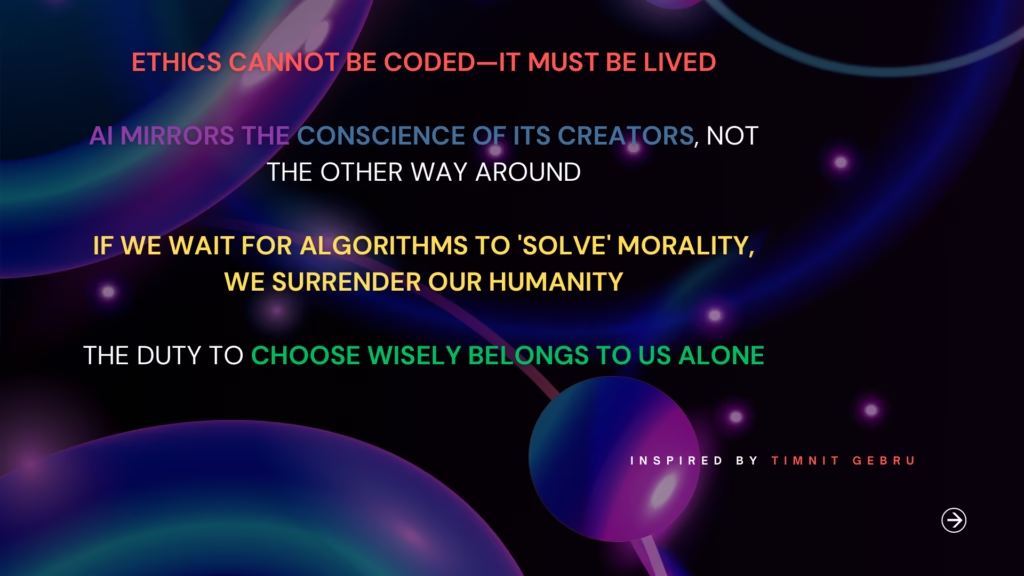
The intersection of AI and ethics raises important issues on accountability and unforeseen consequences at the heart of how technology affects people’s lives.
AI systems must be transparent in order to avoid harm because of their inclusions, which range from loan approvals to medical diagnoses, reflect the values and prejudices of its designers and training data.
As AI imitates human emotions, the distinction between real concern and preprogrammed manipulation becomes increasingly hazy, potentially leading to the exploitation of vulnerability for participation.
- These tools have the potential to undermine privacy, perpetuate inequity, or deceive users through persuasive design if there is unclear accountability.
- The dilemma is not only technological but also ethical: maintaining human dignity in an increasingly automated environment
7. Human Cognition Still Beats AI-
In basic ways, human cognition still outperforms AI, combining creativity, intuition, and contextual awareness in a way that is impossible for robots to match.
Although AI is very good at processing large datasets and identifying patterns, it is not truly capable of understanding them; it has trouble with moral judgment, abstract reasoning, and situational adaptation.
Emotions, cultural nuances, and practical experience are all seamlessly govern by human.
- Skills that enable us to negotiate ambiguity and to reach morally challenging conclusions are beyond AI training data.
- Tasks such as recognising sarcasm, coming up with unique ideas, or learning from a single example, are beyond the capabilities of even the most sophisticated AI.
- Our biological intelligence is still superior in terms of empathy, holistic thinking, and self-reflection—reminders that, despite its immense potential, AI is a tool that is influenced by human minds, not a substitute.
Conclusion
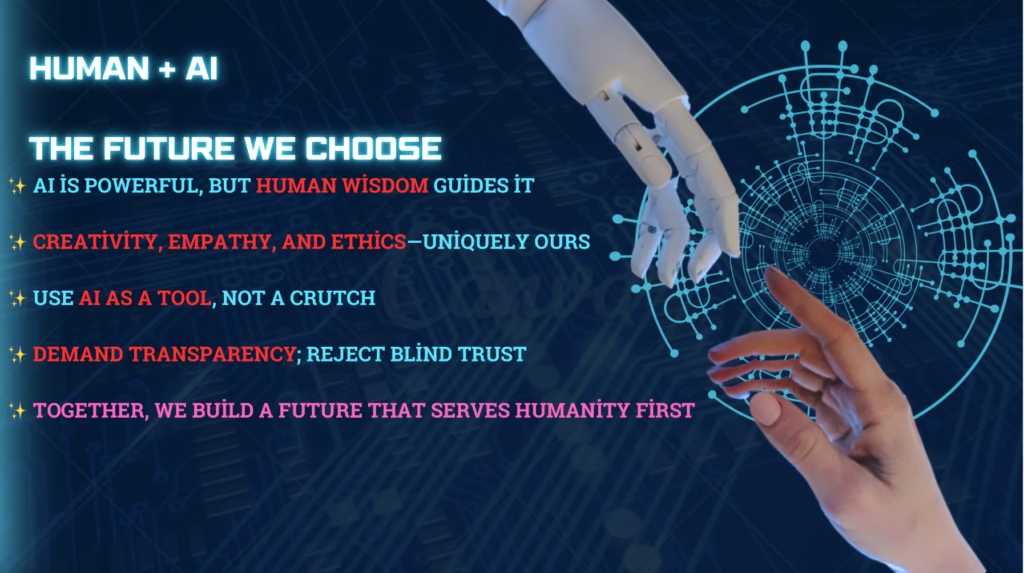
Human knowledge continues to be AI’s compass, directing innovation with empathy, morality, and creativity even as it dazzles with its speed and size.
We are all at a crossroad, where technology has the power to either strengthen or weaken our humanity. We have the option to use AI Partnership as a collaborator, not as a master, fostering innovation, overcoming barriers, and finding solutions to issues that no algorithm can handle.
“We are capable of so much light—let us not forget to build it into the machines,” – Ada Limón
The irreplaceable combination of human and machine is what will shape the future, not only artificial intelligence.
Let’s now demand openness, design ethically, and create an AI era that aligns with our core principles. You are where, the next story begins.
Call to Action:
- Question every algorithm
- Advocate for ethical AI
- And never let technology, outshine our shared humanity
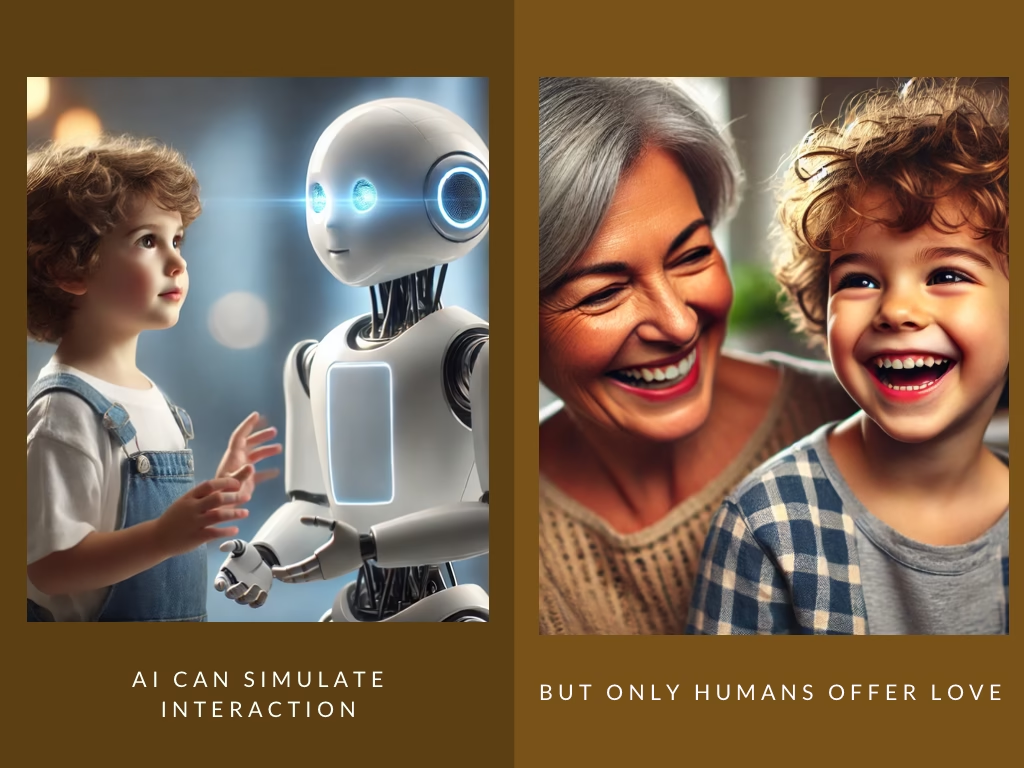
Would you let an AI tuck your child in at night?
Share your thoughts in the comments.

True in a sense that AI can simulate interaction but not love,but that very simulation can be perceived as love if the human mind is exposed to it early and continuously. It’s like someone doing a self breast examination at frequent intervals where in a slowly growing tumour is appreciated as a part of normal anatomy and something as pathological.
*and not something as pathological.
Corrigendum
Your analogy is razor-sharp. Thanks for sharing !AI’s ‘love’ is algorithmic affection—a mimicry that risks rewiring our perception of connection. As doctors, we know early detection saves lives; as humans, this insight may save our humanity.”